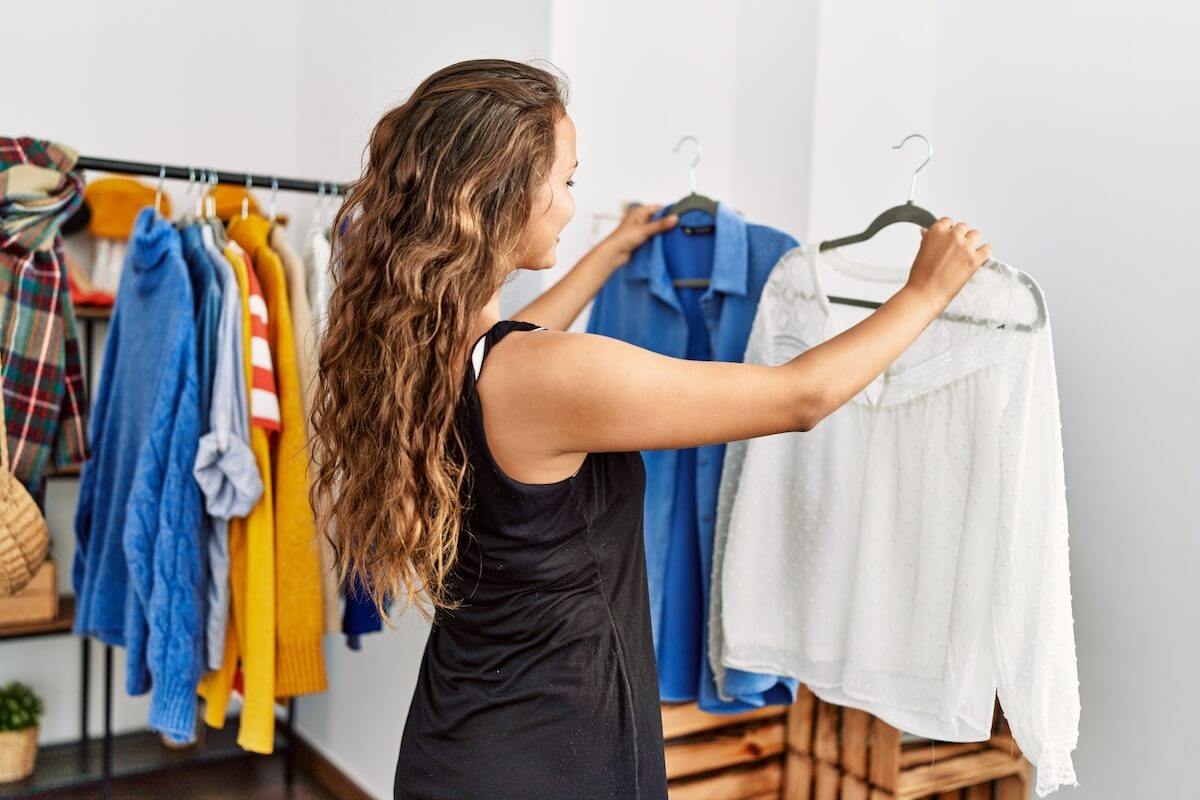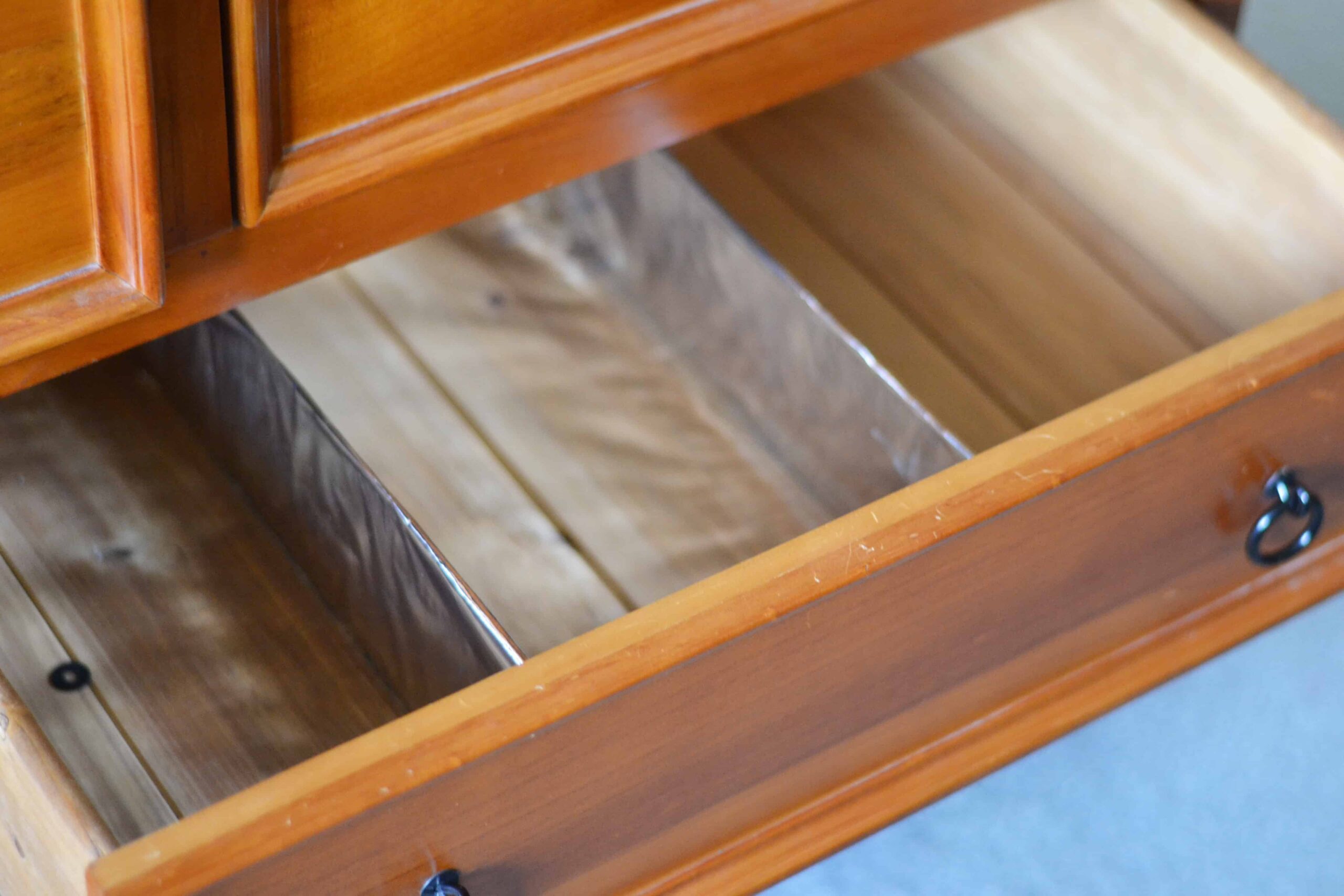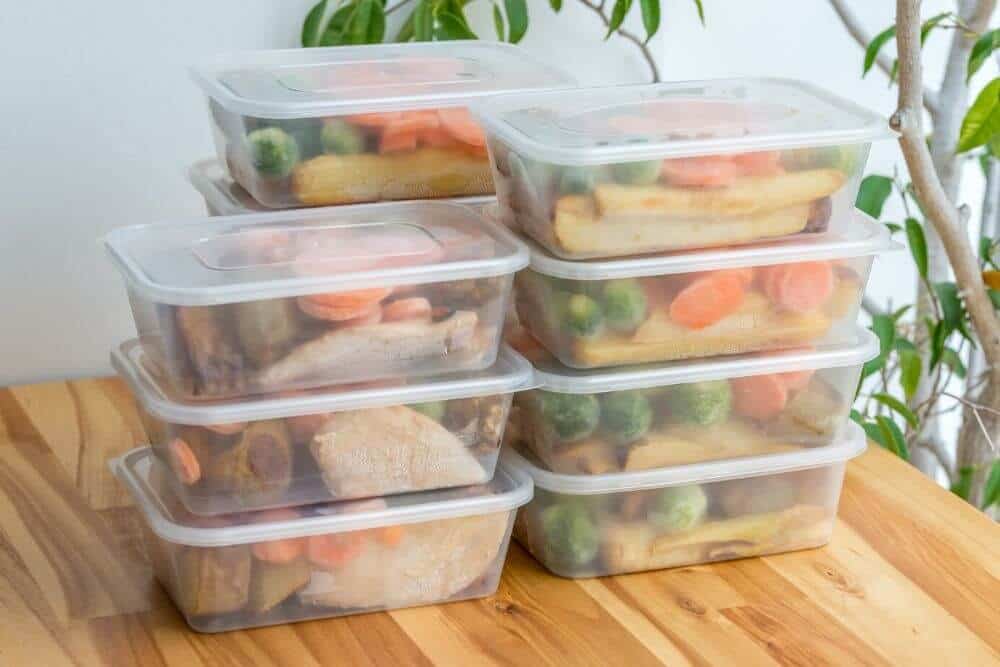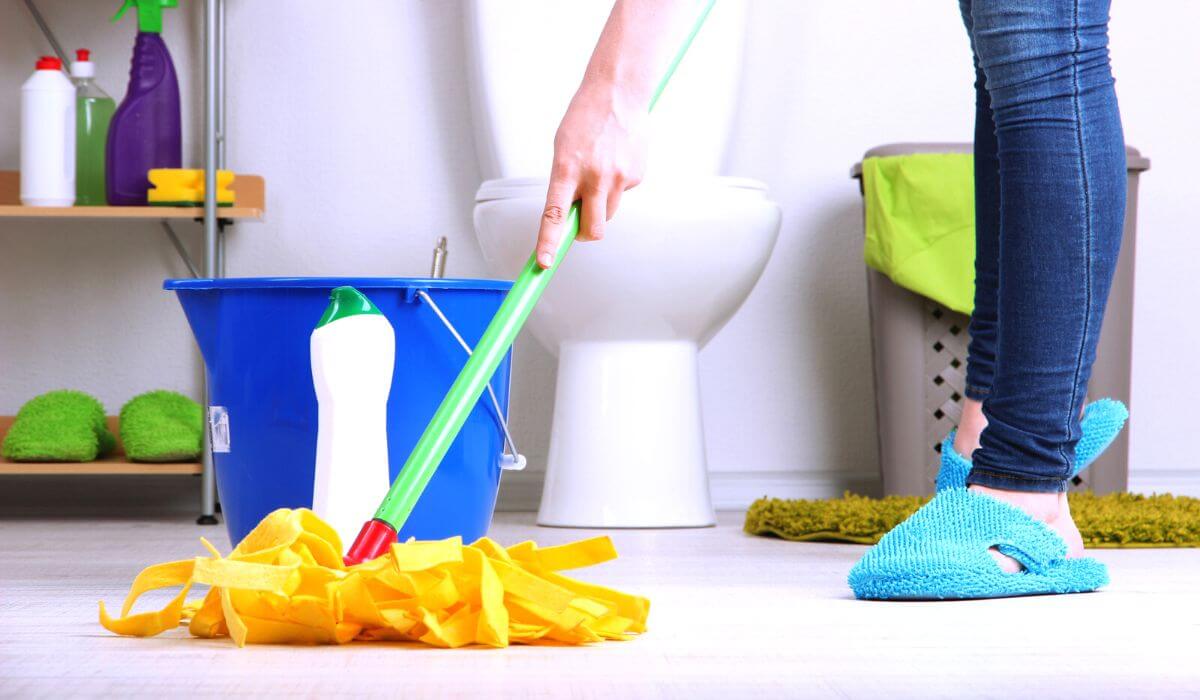How To Declutter Clothes: 5 Steps For Ruthless Wardrobe Decluttering
This post may contain affiliate links. Read the full disclosure
How to declutter your wardrobe and keep it that way! Do you feel like your wardrobe is constantly out of control? Are you struggling to find anything to wear because your clothes are all crammed into drawers? If you can relate, this guide is for you! Learn how to declutter clothes and still have plenty to wear.
This step-by-step guide to decluttering clothes will help you reclaim your space and get your clothing organised! Plus it will help you keep it that way so you can actually find what you want in your closet when you want it!

Table of Contents
How To Declutter Clothing & Keep Them Organised
Decluttering clothing is one of those things that most of us struggle with! The clothing we wear becomes sentimental as we move through life, creating special memories and living through moments that we want to keep in our minds and hearts.
Our emotional attachment can lead us to keep many things we don’t really have space for.
If you don’t manage your wardrobe properly, it can quickly become overwhelming and disorganised.
My favourite wardrobe declutter hack helps me keep mine in check, but that alone isn’t enough to keep a wardrobe decluttered!
Why You Should Purge Your Closet

Regularly purging your closet will not only help you to make space for the clothing that you actually love and wear, but it can also be a very therapeutic part of your bedroom declutter.
Just as some of our clothes bring back wonderful memories of moments they were worn, other clothing in our wardrobe can do the opposite and make us feel guilty or inadequate.
This is especially the case if you’re keeping clothes for when you’re skinnier or after you’ve toned your stomach, or *insert other reason here*.
Or maybe you’re holding onto something because it was gifted to you by someone you love dearly.
It is important to keep in mind that decluttering isn’t just about getting rid of things – it is also about celebrating the pieces that you have kept and finding a way to store them in a more organised and efficient manner.
Having fewer clothing to sift through when you’re getting ready will save you time, remove decision fatigue by having too many choices and help you feel calmer by having an organised space.
Making the conscious decision to eliminate clothing clutter will also help you save money, by being more careful with buying clothes in future.
So now that we know why it’s important to declutter clothes, let’s get into the how:
Decluttering Clothes – My 5-Step Process
There are a few popular methods for how to declutter clothes. While many of these strategies will tell you to pull absolutely everything out at once, that isn’t the method I’m going to share with you today.
Why?
Because it’s freaking overwhelming! I have done this closet declutter method a few times, and yes it is effective, but it’s a lot!
The ‘pull out everything’ strategy is what organising expert Marie Kondo teaches in her Kon Mari method but if you’ve got a mammoth amount of clothing to sort through, it’s going to feel paralysing to see it all in one enormous pile.
And honestly, it feels like it takes much longer than the way I am going to teach you instead.
Here is how to declutter your closet and dresser drawers easily (while still being ruthless):
Step 1: Prepare For Your Declutter

Before you can dig into decluttering your home in any way, you need to prepare yourself. Both mentally and physically.
The mental part of decluttering means getting into the right mindset of letting go of things you no longer need and focusing on the benefits of decluttering.
Do this by creating a goal of what you want to achieve by decluttering your wardrobe.
Do you want to make it easier to find your clothing and accessories? Do you want to eliminate decision fatigue when you try to choose an outfit? Or is it because you want to walk into your bedroom and not feel overwhelmed by all of your stuff?
After this, create a plan to break the task down into smaller chunks and set yourself some realistic goals.
The physical preparation for decluttering involves getting all of the supplies you need before you start.
For clothing and wardrobe decluttering, you will need empty boxes, bin bags or laundry baskets that you can use to sort the clothing you aren’t keeping. Have one for clothes to donate and one for clothes you want to throw away.
If you are struggling to part with a lot of items, a maybe pile might be necessary too (more on that later).
Alright, you’ve got yourself mentally and physically prepared – it’s time to get to action!
Step 2: Divide Up Your Space
Every space we declutter can feel really overwhelming when we see it as a whole – one huge project! But if we divide that space up into smaller areas, it feels much less difficult to get started and get the job done.
This is the same for decluttering clothing.
Grab a piece of paper or use the notes app on your phone to list out each of these individual sections where you store clothing.
For example, each drawer is an individual segment, just like each shelf and each hanging rack.
So instead of one mammoth project, you now have many small projects to tackle. Your list might look like this:
- Underwear drawer
- T-shirt drawer
- Shorts drawer
- Pyjama drawer
- Hanging clothes rack
- Shoe rack
- Belt hanger
- Winter clothes storage
- And so on until you’ve listed each of your different clothing and accessory segments.
Step 3: Declutter Your Clothes

Now it’s time to get ruthless with your clothing!
Pick one of your smaller projects and take everything out of that single space. For example, if you are decluttering a drawer first, only remove the items from that drawer. And make sure you take everything out of the drawer before you start.
Go through each individual item in that space and decide if you want to keep, donate or throw it away. Add the stuff you don’t plan to keep to your donation box, garbage bags or the pile of old clothes you plan to sell.
Step 4: Repeat This Step With Each Section Of Your Clothing
Once you have decluttered your first small section of clothing, do the same for the next and the next until you have gone through each area of your wardrobe and clothing storage and decluttered them.
If your drawers or hanging space are still far too full and overflowing, you might need to go through again and be more ruthless before you move on to the next section of clothing. This should be done before you move on to your next small task.
Keep your goal in mind as you work through your project.
When putting back the clothing you plan to keep in your decluttered closet or drawers, make sure you do this in a way that keeps them organised.
I am a huge fan of vertical folding for dresser drawers, and you can achieve this with drawer dividers to help keep everything organised. The reason this method is great is that you can easily see every piece of clothing in a drawer when you open it!
Check out my tutorial on how to make your own DIY drawer dividers out of cardboard. I first did this around 4 years ago and we are still using these same cardboard dividers!
WANT ACCESS TO MY FREE PRINTABLES LIBRARY?
Step 5: Maintenance
While it might be one thing to get your clothing and accessories under control, it’s another thing to keep it that way. Over time new clothing items come into our homes and it’s easy for things to get out of hand again.
These decluttering tips will help keep your clothing manageable and organised:
- One In One Out – Every time you buy a new item of clothing, donate an existing item, such as the type of item it is replacing.
- Consider your purchases carefully – Before you buy anything, ask yourself this simple question ‘Do I really need this?’ to help you reduce impulse spending.
- Flip your hangers – Turn your hangers around at the start of a new year, flipping them the right way once you’ve worn an item. Anything that is still backward facing at the end of the year can be decluttered.
- Regular Decluttering – Make a plan to declutter your clothing and wardrobes at least every 6 months. Over time, clothing and accessories become worn, may not fit as well or we simply fall out of love with them and this helps us keep on top of things before they get out of control.
What Do Do When You Are Struggling To Part With Clothing

Some items might be easy to make decisions on.
For example, if you wore a shirt 2 days ago and wear it often, it’s a pretty easy decision to keep it. If it’s something torn that you know it can’t be repaired, it should be easy to decide to get rid of such items.
But there will be clothing that we find hard to part with.
In those cases, there are a few strategies you can use to decide what to keep and what to get rid of. Try asking yourself these decluttering questions to help you make your decision:
Is This Item In Good Condition?
Firstly, be realistic about the condition of the clothing. If it is damaged and not easily repaired, or if it is worn, stained, faded, or stretched – these are all extremely good reasons to let go of such items.
In fact, these items in poor condition are the kind that should be put in the bin as they aren’t worth donating to others either. If it can’t be donated, it really shouldn’t be kept!
Does This Item Actually Fit?
Don’t guilt yourself by keeping clothing that is tight or too small. If it is unrealistic that it will fit you in the next 6 months, you are only causing negative emotions by keeping these items of clothing.
You can always buy new clothes if you do reach a weight loss goal in future. This is a great reward for your efforts. If you must keep a goal outfit, keep it to just one! Make it something extra special so that it will feel amazing when you do achieve that clothing goal!
Do I Wear This Regularly?
Can you even remember the last time you wore this article of clothing? If not, it is a good sign that it isn’t serving its purpose in your wardrobe. Let go of clothing items you don’t wear or haven’t worn in the last year can help free up space for the items you really love.
Do I Love This Item?
The way an item of clothing makes you feel can be powerful in helping you make your decision. And this goes beyond whether it makes you happy to look at. Consider if you love how you feel when you wear this item. Does it feel good? Is it comfortable? Do I feel nice when I wear it? All of these are factors to consider when assessing if you love something enough to keep it.
Would I Buy This Item Today?
Imagine that you were out shopping right now and you saw this same item hanging on a rack in the store. Assuming you didn’t already own it, would it be something you would buy again? Our tastes and preferences change often so something you might have loved 2 years ago might not be an item of clothing that you would consider purchasing again now.
You can find more decluttering questions here that you can adapt to clothing and accessories to help you make better decisions on what clothing to keep.
Still Undecided? Try This Ruthless Decluttering Hack

If there are still items you can’t make a confident decision on after asking yourself the quick declutter questions, it might require a different approach.
If in doubt, my rule of thumb is usually to go with the ruthless side and quick sort it into the donate pile, but sometimes something really trips us up.
Add these items to a separate box or basket and make a plan to wear them in the next week or two. Make sure you set a deadline that it must be worn within a set period of no more than 2 weeks. 1 is even better.
If in that time you don’t bring yourself to wear it, you probably won’t wear it again at a later point either.
This is a good way to also assess how an item feels when you have it on. Does it make you feel good? Do you have similar items already? Remember, our goal is less clothes and less stress so be strict about what you keep!
Tips To Declutter Shoes & Accessories
When it comes time to declutter your clothing accessories, including shoes, belts, hats and scarves for example, a similar decluttering process can be used that you have used for the rest of your clothing and closet declutter.
Consider how often you use the item and how much you love it. Assess what kind of condition it is in.
This is especially important when decluttering shoes. There is no point in keeping a pair of runners that have worn soles since they won’t give you the support you need for healthy feet.
A pair of heels with a broken heel is not worth repairing unless you paid a lot for them. In most cases, you are better off investing in a new pair to replace them if you really love them.
As for items such as hats, belts, scarves and other accessories, consider how many you realistically need.
Do you really need 13 caps? Unless you wear caps often, this is probably not necessary! The same goes for scarves. Keep your favourites in a variety of colours and patterns and get rid of the rest.
Off Season Clothes & Speciality Clothing

We all have clothing in our wardrobes or in our clothing storage areas that we don’t wear every day. For example, you may have off-season clothes that are only suitable for winter and otherwise spend half the year in storage.
When it comes time to declutter them, the same simple steps can be used to sort through these remaining clothes and decide if they belong in your simplified closet or if they go on the discard pile.
If you only visit the snow once every few years but have a heap of snow jackets, pants and snow boots taking up space, it is well worth considering if you can instead hire or borrow these items when you need them instead.
For evening dresses or formal wear, if you rarely have an occasion where these types of outfits are needed, reducing your options to just 2-3 items instead of 10 will free up so much space!
This is also another situation where you might consider hiring formal wear instead of owning it. The great thing about the many clothing hire services is that you can have a whole different look each time you have a special occasion to attend, without having to spend a load to buy and then store fancy gowns in your home wardrobe!
What About My Wedding Dress?
If you have your wedding dress still and are keeping sentimental pieces such as this, perhaps to give to your daughter when she is older, there are a few things to consider.
Remember styles are always changing and it’s likely she won’t want the same style you did.
If you don’t have a daughter, is there another reason you are holding onto your dress? Can you instead preserve the memory through photos or have it made into something you can wear?
If you still decide to keep your wedding dress, you can have it professionally cleaned and stored in a box that will likely make it much more compact than having it hanging in your closet. It will be far better protected this way as well!
What To Do With The Clothing You Get Rid Of

After you have finished decluttering your clothing, it is important to take action on the items you have decluttered quickly!
If these items stay in your home too long, there’s a risk that you might change your mind and put them back into your closet.
The best thing to do with your decluttered clothing is to donate it. Check out local charities in your area to find out their requirements and how you can donate the items you have decluttered.
Set yourself a strict deadline to donate your unwanted clothing within the first few days of finishing your wardrobe declutter.
If you can’t get it to a charity shop soon, list it for free on an online marketplace such as in the Facebook giveaway groups for your area. I have found that these types of giveaways go really quickly as there is always someone in need who will be grateful for your unwanted clothing that is in good shape.
You are paying it forward so you should feel great about that!
Any clothing that is not suitable for donating should be recycled if possible, or thrown away.
Don’t feel bad about throwing away clothing that is not fit for donating or recycling. Clothing is made to be worn and if you’ve worn something to the point of wearing it out, that means it has served you well!
If you do have some items of clothing or accessories that are in excellent condition and are high value, you might consider selling these items. This can be a lot of effort so really assess if the money you will make is worth the effort it takes.
Personally, I always focused on the money wasted by not selling my unwanted stuff and wanting to try and recover some of these costs. However, when I experienced the mindset shift that often we get greater value out of simply getting these things out of our lives quickly instead, it really helped me move forward with simplifying my home!
Creating A Capsule Wardrobe
The idea of a capsule wardrobe might sound intimidating, but it is actually a really useful tool to help you create an efficient wardrobe full of only the times you love.
A capsule wardrobe usually consists of around 25-30 pieces of clothing that are versatile and suit your personal style. These are the items that you wear often and feel great when wearing them.
They are also items that pair well together so you can mix and match your tops, bottoms and accessories to create different combinations of outfits.
By creating a capsule wardrobe, you eliminate decision fatigue, which occurs when you have far too many options and can’t decide what to wear.
A simplified wardrobe is a fantastic option if you want to embrace a more minimalist lifestyle. Especially if you have a small amount of storage space in your wardrobe.
It’s certainly not for everyone and I personally have not embraced the capsule wardrobe method, but it is a great option for many people.

Decluttering your clothing can be a daunting task but it doesn’t have to be. By using the steps outlined in this article, you can make decluttering decisions quickly and easily on what clothing items to keep and which ones to donate or recycle. Remember that decluttering isn’t just about getting rid of things – it’s also about creating more space for yourself mentally as well as physically!
I hope these simple tips help you with how to be ruthless when decluttering clothes so you can declutter your wardrobe and keep it organised!
For more cleaning & decluttering tips:
- How to start decluttering when you feel overwhelmed
- How to declutter toys
- 30-day declutter challenge calendar
- 10-minute decluttering tasks and quick wins
- How decluttering can save you money
- The 1 box decluttering method
- How to declutter your garage
- How to create your own home management binder
- Outdoor toy storage ideas
- Toy storage ideas for kids
- Things you can throw away right away
- How to declutter your kitchen
- How to declutter your bedroom
- How to declutter your bathroom
- Books about decluttering
- How to organise paperwork
- Cleaning hacks to save time
- How to declutter your living room
- How to clean a really messy house
- 30 bags in 30 days declutter challenge







